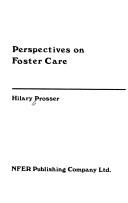| Listing 1 - 10 of 403 | << page >> |
Sort by
|

ISBN: 0856331473 9780856331473 Year: 1978 Publisher: Windsor: NFER,
Abstract | Keywords | Export | Availability | Bookmark
 Loading...
Loading...Choose an application
- Reference Manager
- EndNote
- RefWorks (Direct export to RefWorks)
Book
Abstract | Keywords | Export | Availability | Bookmark
 Loading...
Loading...Choose an application
- Reference Manager
- EndNote
- RefWorks (Direct export to RefWorks)
Book
Year: 1974 Publisher: Rome: Ed. Agency,
Abstract | Keywords | Export | Availability | Bookmark
 Loading...
Loading...Choose an application
- Reference Manager
- EndNote
- RefWorks (Direct export to RefWorks)
Book
ISBN: 2877100510 9782877100519 Year: 1991 Publisher: Vanves: CTNERHI,
Abstract | Keywords | Export | Availability | Bookmark
 Loading...
Loading...Choose an application
- Reference Manager
- EndNote
- RefWorks (Direct export to RefWorks)
Book
ISBN: 071006800X Year: 1970 Publisher: New York (N.Y.) : Routledge and Kegan Paul,
Abstract | Keywords | Export | Availability | Bookmark
 Loading...
Loading...Choose an application
- Reference Manager
- EndNote
- RefWorks (Direct export to RefWorks)
Book
ISBN: 2100559389 Year: 2011 Publisher: Paris : Dunod,
Abstract | Keywords | Export | Availability | Bookmark
 Loading...
Loading...Choose an application
- Reference Manager
- EndNote
- RefWorks (Direct export to RefWorks)
Vous pratiquez le métier d'assistant familial ou vous envisagez de vous y impliquer ? Vous avez un poste à responsabilité dans les services de placement familiaux ? Vous formez des assistants familiaux ? Vous vous intéressez tout simplement à ce métier ? Corinne Verdu vous propose une réflexion sur les impacts de ce métier particulier sur l'équilibre familial, à travers un recueil de témoignages et quelques arrêts sur images. Ce livre vous aidera à progresser dans la prise en charge et l'accompagnement des enfants placés.
Book
Year: 1999 Publisher: Washington, D.C. : International Monetary Fund,
Abstract | Keywords | Export | Availability | Bookmark
 Loading...
Loading...Choose an application
- Reference Manager
- EndNote
- RefWorks (Direct export to RefWorks)
In recent years, the IMF has released a growing number of reports and other documents covering economic and financial developments and trends in member countries. Each report, prepared by a staff team after discussions with government officials, is published at the option of the member country.
Book
ISBN: 9782343244259 Year: 2021 Publisher: Paris : Harmattan,
Abstract | Keywords | Export | Availability | Bookmark
 Loading...
Loading...Choose an application
- Reference Manager
- EndNote
- RefWorks (Direct export to RefWorks)
De l'enfant placé à l'enfant confié, prend appui sur une triple expérience de Philippe Fabry, d'éducateur, de formateur et de chercheur. L'organisation française de la protection de l'enfance a une particularité qui apparaît avec force quand on la compare avec celle des pays voisins, « l'idéologie du retour » : quand un enfant est placé, un retour auprès de ses parents doit par principe rester possible. Logiquement, il en résulte qu'un placement doit rester provisoire. Ce fonctionnement a deux grands fondements : anthropologique et juridique. Dans les situations de placement durable, le prix pour l'enfant est une fausse stabilité, car il est confié à une institution et non pas à des adultes reconnus en tant que parents d'éducation. Sa place est durablement provisoire, en famille d'accueil ou en foyer, ce que le passage à la majorité révèle souvent brutalement
Book
Year: 1989 Publisher: [Washington, D.C.] : U.S. General Accounting Office,
Abstract | Keywords | Export | Availability | Bookmark
 Loading...
Loading...Choose an application
- Reference Manager
- EndNote
- RefWorks (Direct export to RefWorks)
Book
Year: 2023 Publisher: Washington, DC : World Bank,
Abstract | Keywords | Export | Availability | Bookmark
 Loading...
Loading...Choose an application
- Reference Manager
- EndNote
- RefWorks (Direct export to RefWorks)
This study investigates the effects of public transfers and taxes on the wellbeing of children in Ethiopia. It applies the Commitment to Equity for Children methodology to examine the burdens of taxation and the benefits from government transfers and spending, and their differential wellbeing impacts on children. The study integrates data from the 2018/19 Ethiopia Socioeconomic Survey, which also collected data on taxes and transfers, with administrative data. Measuring its distribution by child monetary and multidimensional wellbeing, the study finds, on average, a progressive, poverty-reducing and equalizing fiscal system. However, there are important differences in the distribution of some of its elements. Indirect taxes, comprising of value-added and excise taxes, are regressive. Similarly, primary education spending, the largest of in-kind transfers, is only progressive in urban areas. On poverty and inequality, the fiscal system reduced the monetary child poverty headcount by 21 percent and the poverty gap by 33 percent. The effect is stronger for girls and children in rural areas than for boys and children in urban areas, therefore reducing inequalities in poverty rates. However, this is only the case when in-kind transfers for education and health are considered. Without the inclusion of in-kind transfers, the study finds that the fiscal system is not well calibrated to reduce poverty. This highlights the essential role of public services, not only in delivering fundamental child rights, but also in reducing poverty among children.
| Listing 1 - 10 of 403 | << page >> |
Sort by
|

 Search
Search Feedback
Feedback About UniCat
About UniCat  Help
Help News
News